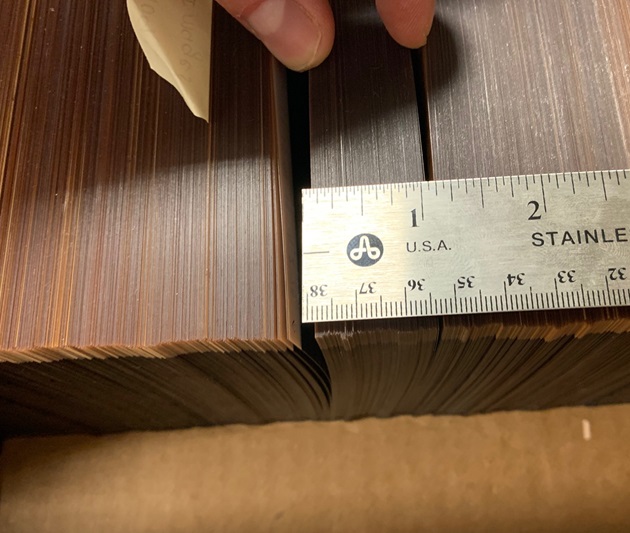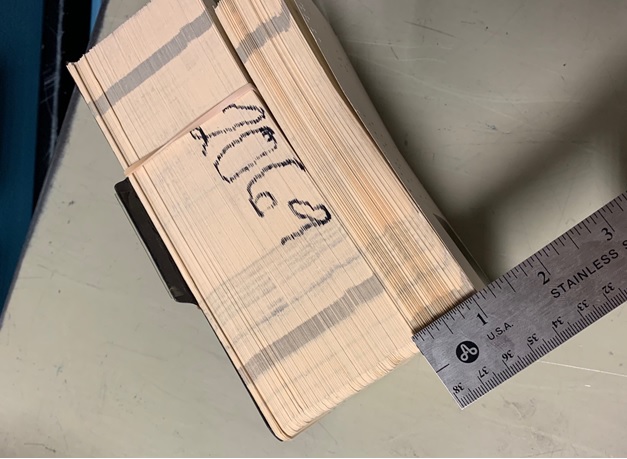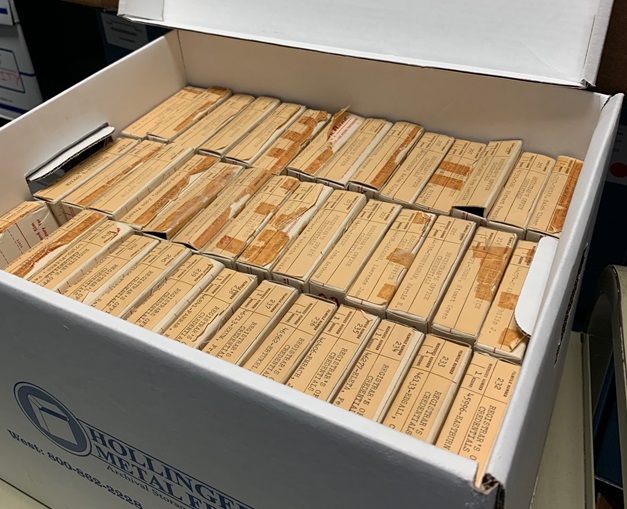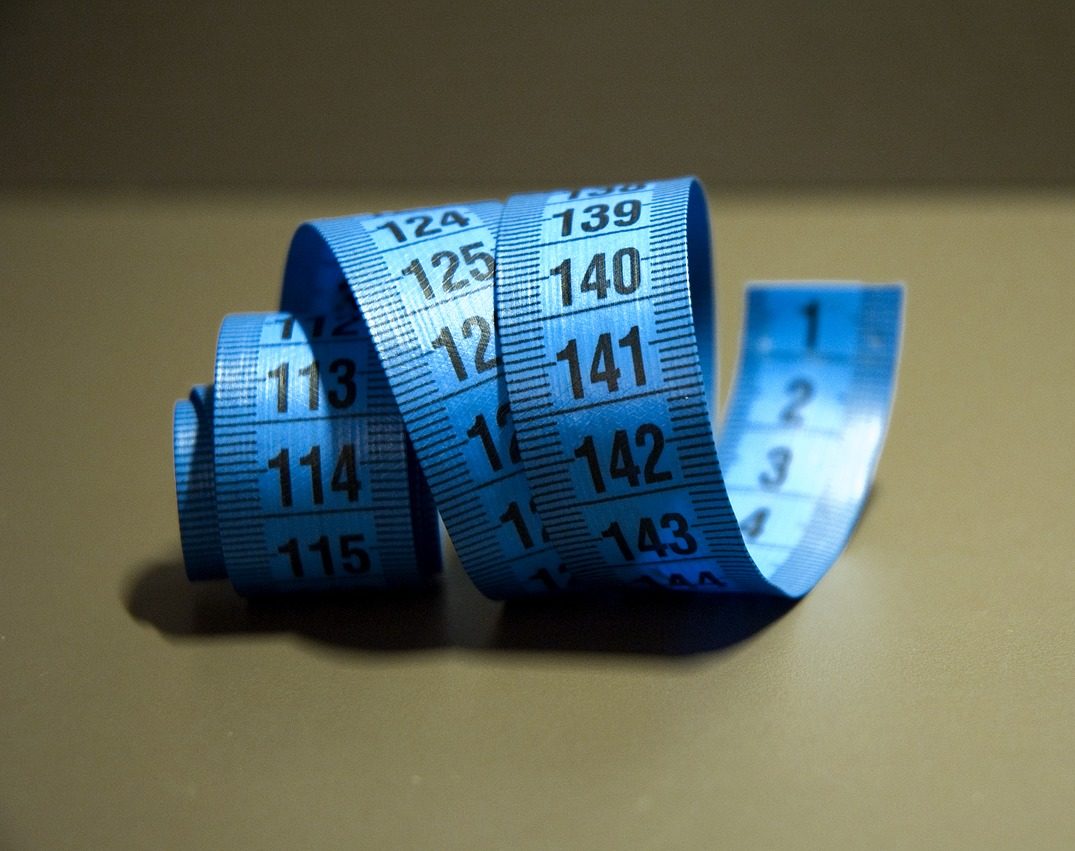Having received thousands of calls and emails over the years in the digital scanning business, we know that not everyone that comes into contact with microfiche (and microfilm and aperture cards) has the level of knowledge about it that we do, and that’s great! Because if everyone knew what we did, we wouldn’t be useful as an expert digital conversion company.
And one of the most common discussions we have with the folks that get in touch with us is how to determine how many sheets of microfiche, reels of microfilm, and number aperture cards that they have. In this article we’ll describe how you can estimate the number of units you have so that when you contact us, or another company like us, you’ll have that piece of information on the tip of your tongue to jump right into the conversation about your scanning project.
Why You Need To Know How Much Microfiche You Have
Need might be a bit too strong of a word, but it’s definitely nice to know how much material you have before you start looking into a digitization project. A normal conversation about microfiche usually starts with someone filling out a form on our website or giving us a call. After the usual pleasantries and small talk, the conversation turns to business.
Potential customer: “So I have some microfilm and microfiche and I’d like to know how much it costs to get it scanned, and also how long it’ll take.”
BMI rep: “Sure thing. This is right in our wheelhouse and both the cost and the timeline to complete the project will depend on how much material you have, what type it is, and what your project goals are. First things first, can you tell me how many microfilm rolls and how many microfiche sheets you have?”
Customer: “A lot!!”
BMI: “Wonderful! We’re really great at large projects. So how many rolls of microfilm and how many sheets of microfiche?”
Customer: “Actually, I’m not sure. I have some boxes of film and some drawers of fiche, but I really don’t know a number I could give you.”
Then there’s some explanation, probably a follow up email with some methods to determine volumes, then more calls to make sure, and so on.
Instead of making you go through this whole process when you get in touch with us, we thought you’d appreciate it if we just explained it here so you can figure it out before having to talk to a company that will try to sell you something.
However, we really like to chat on the phone and if you’d like to have a conversation similar to what you’ve just read, absolutely give us a call: 800-359-3466 (800-FLY-FILM). You read that right, our number spells out “FLY FILM.”
What Kind Of Microfilm Do I Have?
The term “microfilm” is often used interchangeably when referring to the various types of microforms: microfilm reels, microfiche sheets, and aperture cards.
If you’re not sure which kind you have, we suggest you hop over to our page that describes the different types of microfilm and provides some images to help you understand which type you have.
How To Estimate Microfiche
Microfiche, the wily little beast of the microform world! This type of material is always the trickiest because for even a small project, you may have hundreds or thousands of sheets that you’re just not going to count! So what can you do?
Measure!!
That’s right, measure, as in getting a ruler or measuring tape and figuring out lengths in feet or inches.

1 inch of microfiche is about 90-110 sheets.
1. Estimating microfiche using the measurement method
Here’s how you measure microfiche to get a volume count:
- With your microfiche stacked together, measure an inch.
- Pull out that stack of microfiche that measured an inch.
- Count (be precise here!) how many fiche are in an inch.
- Measure the linear inches (or feet if you have a lot) of your collection of fiche.
- Multiply the number of inches by the number of fiche per inch…
- Voila! You have your estimate.
This isn’t a perfect method, but it’s about as close as you’re going to get unless you want to spend hours or days trying to count thousands upon thousands of fiche if you have a large project.
Different parts of your fiche collection might be organized differently, such as having more or fewer envelopes that hold the fiche, or stacked more tightly or more loosely together, which will affect the number of fiche per inch, but that’s not the point. The point is that you’re trying to get a pretty good estimate of how much you have so that the company you’re working with can generate a price to scan your records.
If you want to skip the part about pulling out an inch and counting them, you can use 90-110 fiche per inch as a general rule of thumb.
2. Estimating microfiche by drawer and cabinet
Like the microfilm example earlier, plenty of companies store their microfiche in cabinets, likely the Russ Bassett variety.
The horizontal style cabinets (drawers that are 36” wide x 24” deep) hold 17,800 microfiche per drawer. These come in 5, 7, or 10-drawer sizes.
The vertical style cabinets (drawers that are 21” wide x 29” deep) hold 12,870 microfiche per drawer. This is a 10-drawer cabinet.
If you have 2 5-drawer horizontal style cabinets that are full of microfiche, you’re looking at 178,000 microfiche sheets:
17,800 fiche per drawer x 5 drawers per cabinet x 2 cabinets
= 178,000 fiche
How To Estimate Aperture Cards
1. Estimating aperture cards using the measurement method
Determining how many aperture cards you have is pretty much the same as fiche (see “Estimating microfiche using the measurement method” above). If there aren’t any envelopes or separators, you’re probably close to 100-120 cards per inch.

1 inch of aperture cards is about 100-120 cards.
2. Estimating aperture cards by drawer and cabinet
Using the same methodology as estimating microfiche, below are examples of aperture card storage cabinets:
The horizontal style cabinets (drawers that are 43” wide x 18” deep) hold 8,250 aperture cards per drawer. These come in 6, 8, or 12-drawer sizes.
The vertical style cabinets (drawers that are 25” wide x 29” deep) hold 8,050 aperture cards per drawer. These come in 6, 8, 11, or 12-drawer sizes.
If you have 3 6-drawer horizontal style cabinets that are full of aperture cards, you’re looking at 178,000 aperture cards:
8,250 cards per drawer x 6 drawers per cabinet x 3 cabinets
= 148,500 cards
How To Estimate Microfilm
Microfilm is the easiest type to get an estimated volume because of three things:
- If you have a large amount of film, say 1,000+ rolls, your organization probably has some type of inventory that will tell you how many you should have.
- If you have a small amount of film, say less than 200 rolls or so, it’s probably in a couple of boxes and you can do a quick box count and get a rough number.
- Even if you have a large amount of film, like in the multiple thousands, as long as it’s stored in a relatively nice way, it’s just an easy type of material to count because the reels will be in a cartridge or box that’s easy to see and count.
1. Estimating microfilm by storage box
If your microfilm is in standard storage boxes (aka “banker’s boxes”), there’s a simple calculation to get an estimate:
16mm microfilm: 90 rolls per box
35mm microfilm: 52 rolls per box
Those numbers assume the boxes are full, but that’s a good place to start.

Almost full box of 16mm microfilm, approximately 90 rolls.
2. Estimating microfilm by drawer and cabinet
Many folks that still have microfilm keep their rolls in cabinets, and one of the most common types of cabinet is the Russ Bassett.
The horizontal style cabinets (drawers that are 36” wide x 24” deep) hold 154 16mm or 91 35mm rolls per drawer. These come in 6, 8, or 12 drawer sizes.
The vertical style cabinets (drawers that are 25” wide x 29” deep) hold 130 16mm or 81 35mm rolls per drawer. This is a 12-drawer cabinet.
So if you have 3 vertical style cabinets that are full of 16mm microfilm, you’re looking at 4,680 rolls:
130 rolls per drawer x 12 drawers per cabinet x 3 cabinets
= 4,680 rolls
Next Steps
Reach out to us today! Click the “Get Your Quote” button below, fill out the form, and we’ll quickly reply to you to discuss your project.
Further Reading
Below are some additional articles related to microfilm, microfiche, and aperture card scanning – check them out to learn more about digitization.
“How Much Does Microfiche Scanning Cost?” describes the 9 factors that affect the price you’ll pay for microfiche scanning. You can use this article to give you a ballpark idea of what you’ll need to budget for your digitization project!
“The BMI Microfilm Scanning Process” is our 10-step approach to microfilm scanning. If you work with us, this process is the digital conversion journey your microfilm will go through.
“Traditional Microfilm Conversion vs. Digital ReeL” is a comparison between what we call a “traditional conversion” and our microfilm solution, “Digital ReeL.” If you’re not sure of the options you have available when it comes to microfilm , this is a great place to start to get an idea of which one might be best suited for your project.
“Microfilm Transportation” is an overview of three methods we most commonly see and use with our clients. If you’re concerned about the safety and security of your records during transportation, this is a great place to start to see what we offer.

